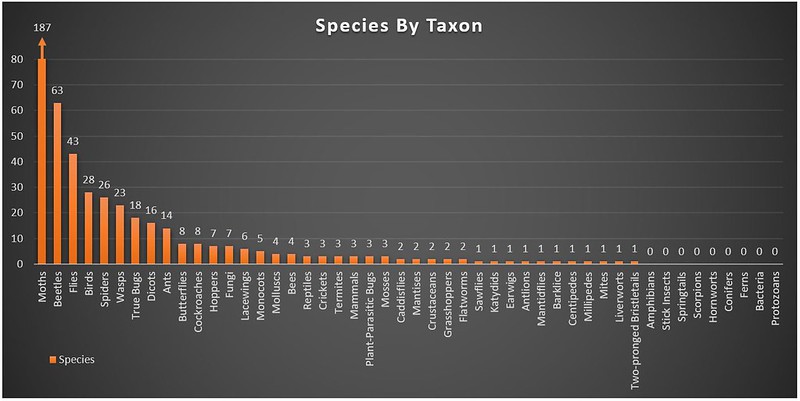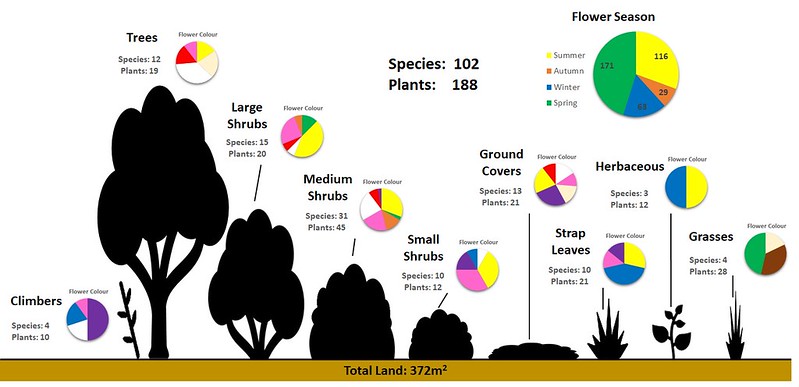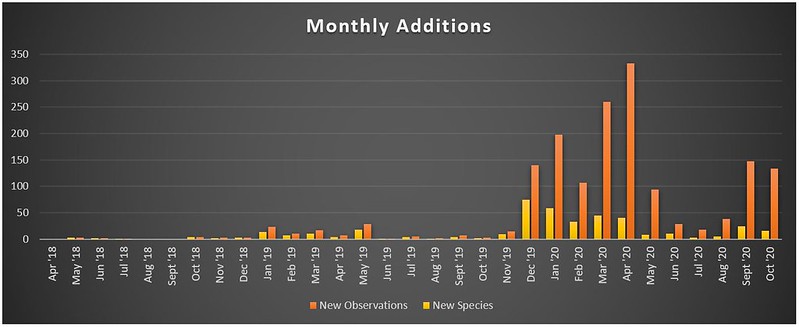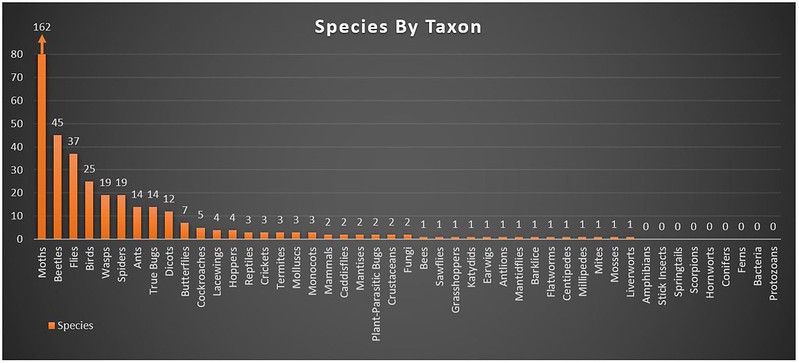Background
As of October 2020 just over
400 species had been recorded on
this suburban property. As of the end of April 2021 this has risen to
507 species from 2,315 observations.
New Additions
The new additions are mostly increases in the largest taxa already recorded. 18 new Moths, 16 Beetles, 6 Flies, 6 Spiders & 4 Wasps. Below are a few of the more interesting observations. Many have been sighted in association with an upgraded UV light setup.



Current Activities
Effort has been made in the last eight months to restructure the yard with the specific intent on maximising invertebrate biodiversity. All remaining lawn has been removed. Additional plant species from around Greater Adelaide region have been planted during Spring and Autumn, selected to provide a mix of vegetation heights, flowering times, flower colours and fleshy fruits. Fresh water sources at height and ground level, and scattered groundcovers (rocks, logs) have been added. A majority of the plants should be sufficient size by Spring to begin having an effect on the species in the yard, with many already attracting various species.

Animal / Plant Associations
To measure any effect of the modified environment, each plant has been given a number. Any animal species observed interacting with the plant in any way has the associated iNat observations tagged with the plant ID. As such iNat observations can be filtered to show any associations. Currently associations have primarily been chance observations, with a few intentional searches to determine suitable methods. Associations are likely to depend on variables such as time of day, season, weather and temperature, flowering and fruiting. A more formal approach will be taken from Spring 2021 once the plants are established. Some early associations include
8 species recorded on Xerochrysum bracteatum and
8 species on Eucalyptus scoparia.
Current Issues & Limitations
Choice of plant species has been restricted to species that are suited to the sandy and limestone soil. Common Heath (Epacris impresa) would make a valuable Autumn flowering addition given that Eastern Spinebills (Acanthorhynchus tenuirostris) are seasonally seen and heard, but it's unlikely to fare well in the soil.
Most plant species to date are woody perennials which function as long term structure and may need several years growth before producing a significant number of flowers & fruit. Herbaceous species often favoured by Hemipterans are in limited supply. These can present difficulties for long term establishment if they are annuals that may not self seed well. These will require some trial and error. The Calostemma purpureum (Garland Lilys) have already succumbed to the Threeband and Yellow Cellar Slugs. Tuberous species may be the way to go with Bulbine bulbosa (Bulbine Lily) and Arthropodium strictum (Common Chocolate-lily) already re-sprouting, provided the slugs don't find them.
Additional watering over the dry season is likely to be the norm, so species that may respond poorly to such, for example Drosera species, are not going to be suitable.
There are only a limited number of local plant species that flower in Autumn. This may limit the opportunity for species to inhabit the yard all year round.
Lessons Learnt
Anything Can Be a Home:
While it's valuable to provide vegetation 'layers' ranging from trees to shrubs to ground covers, this alone isn't sufficient for invertebrates, many of which are ground dwelling. A temporary garden border of widely spaced old paving bricks has now become home for 10 or so species, including Ants, Earwigs, Millipedes, Centipedes, Termites, Woodlouse, Two-pronged Bristletails, and Pseudoscorpions. In one section of the yard more than half of the bricks have
Nylanderia Ant nests under them. Given that anything placed on the ground eventually becomes a home to ground dwelling invertebrates, the few token rock piles and old logs placed around the yard are likely insufficient. A much larger range of scattered debris, in both exposed and shaded areas would be of benefit.
Opportunity Costs:
With only 372m
2 of land available, any decision on area usage has an opportunity cost. It would be easy to plant out a large area with 'butterfly attracting' species, however this would be at the expense of alternative plant species that may be of greater value to other taxa. As such the focus is on limiting the number of each plant species and focussing on plant diversity.
Degree of Utilisation:
Each square meter of the available land falls on a spectrum from entirely modified for human use to partially modified to natural state. A concrete path would represent an area entirely modified, whereas a garden with mulch, leaf littler and established plants would represent a natural state. In order to maximise biodiversity, as much area as possible is given over to a more natural state. All path areas are unmodified, covered with leaf litter and without borders.
Intrusion of Nature:
While attracting wildlife to your yard is considered to be a positive, this generally relates to 'pretty' species such as Birds and Butterflies. Returning an area to a more biodiverse state does require an increased tolerance of potentially less desirable species. A large number of
House Spiders (Badumna sp.) are present with their messy webs. Their presence in numbers indicates a sufficiently large local insect population to sustain them.
Redback Spiders (Latrodectus hasselti) are anecdotally increasing in number.
Wolf Spider (Lycosidae sp.) burrows litter the yard. These also have a habit of finding their way indoors at night and cannot find their way out without assistance. The heavily tree-shaded area attracts
Southern House Mosquitoes (Culex quinquefasciatus) and
Striped Mosquitoes (Aedes notoscriptus). These are not breeding in water sources on the property so are likely coming from the surrounding area. While they are a nuisance, they may be a valuable food source for the local
Silvereyes (Zosterops lateralis) and
New Holland Honeyeaters (Phylidonyris novaehollandiae) that are frequently seen pulling Insects from the air.
Still "Needs ID"
The current number species observed may in fact be higher, with many invertebrates having been only identified to Family or Genus, with some stuck at Order. If you have any expertise in the following areas, your assistance with IDs in the following groups would be appreciated. Many of the observations have macro-level photos from multiple angles.
Needing ID:
Moths
Spiders
Plants
Ants
Flies
Beetles
Wasps
Bugs
Everything Else











